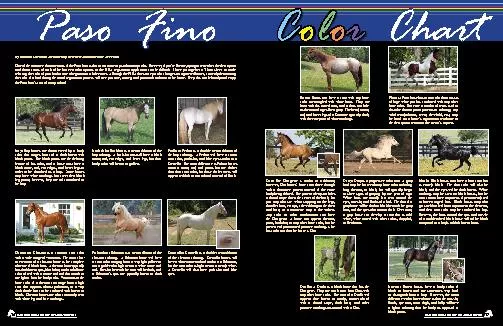

One of the attractive characteristics of the Paso Fino is that it can come in just about any color However if youre like me trying to remember the description and distinct traits of each of the ID: 835852
Download Pdf The PPT/PDF document "By Shanon awkins Membership ServicesAdmi..." is the property of its rightful owner. Permission is granted to download and print the materials on this web site for personal, non-commercial use only, and to display it on your personal computer provided you do not modify the materials and that you retain all copyright notices contained in the materials. By downloading content from our website, you accept the terms of this agreement.
1 By Shanon awkins, Membership Services/Ad
By Shanon awkins, Membership Services/Administrative Assistant One of the attractive characteristics of the Paso Fino is that it can come in just about any color. However, if you’re like me, trying to remember the description and distinct traits of each of the fourteen color options on the PFHA registration application can be dif�cult. I have put together a “cheat sheet” to make selecting the color of your foal at time of registration a little easier. Although the FHA does accept color changes on registered horses, correctly determining the color of a foal during the initial registration process will save you time, money, and potential confusion in the future. Keep this article handy and enjoy the Paso Fino’s coat of many colors! Bay: Bay horses are characterized by a body color that ranges from red to dark brown with black points. The black points are the de�ning feature of this color, and a horse must have a black mane, tail, ear edges, and lower legs in order to be classi�ed as a bay. Some horses may have white markings that cover their black leg points; however, they are still considered to be bay.hestnut: hestnut is a common coat color with a wide range of variations. he main characterization of a chestnut horse is the complete absence of black hairs. A chestnut horse typically 26ASO F WOEPT/ C o l o r Chart Gray: Gray is a progressive color trait. A gray foal may be born with any base color including bay, chestnut, or black, but will typically begin to show signs of graying by one year of age. White hairs are usually �rst seen around the eyes, muzzle, and �anks of a foal. The skin of a gray horse will be dark or black beneath the gray hair, and the eyes also remain dark. Over time, a gray horse can develop a coat that is solid white, white mixed with other colors, dappled, or �ea-bitten.Black: Black horses must have a hair coat that is entirely black. he skin color will also be black, and the eyes will be dark brown. White markings may be seen on black horses, but the coat cannot have any areas of permanently red or brown tinged hair. Black horses may also get sun-bleached from exposure to the elements, and their coat color may be confused for bay. However, the hairs around the eyes and muzzle of a sun-bleached black horse will still be black compared to a bay’s reddish brown hairs. Brown: Brown horses have a body color of black or brown and are sometimes very hard to distinguish from a bay. However, the main difference with a brown horse is that the muzzle, �anks, eye area, inner thigh, and belly will have a lighter coloring than the body as opposed to black points.he Dun gene is similar to a dilution; however, Dun horses’ base coat show through with a distinctive pattern instead of the entire body being diluted. he pattern always includes a dorsal stripe down the center of the back, but you may also see zebra stripping on the legs, shoulder bars, ear tips, cob-webbing on the chest and face, or a transverse strip at the withers. Any color or color combination can have the Dun gene. A horse can appear chestnut, pinto, buckskin, or any other base color, but the presence of pronounced primitive markings is the best indicator that the horse is Dun.Pinto: A into horse has a coat color that consists of large white patches combined with any other base color. here are a number of terms used to describe distinct pinto patterns or coloring; any valid term (tobiano, overo, skewbald, etc.) may be listed on a horse’s registration certi�cate in the description section at the owner’s request.oans can have a coat with any base color intermingled with white hairs. hey are born with this mixed coat, and it does not fade as the animal ages like a gray. he head, mane, tail, and lower legs of a oan are typically dark, with the exception of white markings.Grulla: A Grulla is a black horse that has the Dun gene. hey are much rarer than Duns with any other base color. he coat of a Grulla will appear slate brown or smoky, mouse-colored with a dorsal stripe, dark face, and other primitive markings associated with a Dun. ASO FNO HO WORLD · EPT/CT/NOV 2011 27